What are the signs of sugar-glider depression?
Like any other pets, sugar gliders may exhibit abnormal behavior such as frantically running around, loss of appetite, or overgrooming.
If you note any of these habits, chances are your sugar glider is depressed, and you need to do something about it.
Stick with me as I take you through signs that your sugar glider is depressed, why they may be so blue, and what you can do to change that.
8 Signs of Depression in Sugar Gliders
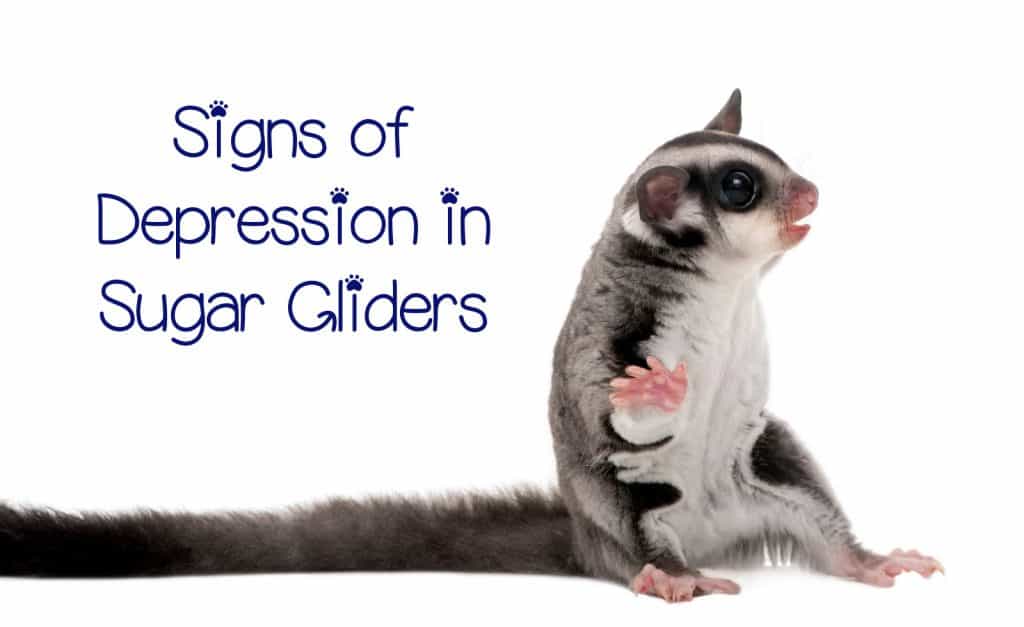
1. Loss of Appetite
Depressed sugar gliders may seem disinterested in food, and in some worst cases, some will stop eating altogether.
A loss of appetite is common when sugar gliders get to a new home. Failure to eat is not good for their health, and they could eventually die.
You can try feeding them baby food using syringes. However, sugar gliders may stop eating because they’re suffering from low blood sugar or other health issues.
If seizures, weakness, or tremors accompany the lack of interest in eating, contact your Vet as soon as possible.
Constipation and overeating are other food-related signs of depression in sugar gliders.
Check out the video below from The Incredible Dr. Pol to learn more about sugar glider appetites:
2. Overgrooming
Overgrooming is a common sign of stress in most small pets, including sugar gliders. These pets are known for grooming themselves often.
However, they tend to overdo it when they’re not okay. You’ll notice some bald sections on your sugar glider’s coat, and you may also come across fur lying in the cage.
While overgrooming is often a sign of stress, it could also be a sign of pain.
If the bald patches appear in multiple sections on the sugar glider, it’s most probably a sign of overgrooming.
But if it’s one large bald section on a specific area, that could result from an illness.
For instance, if your sugar glider is scratching around the cheek, they could be trying to ease pain caused by a tooth abscess.
It’s best to visit your Vet and get a proper diagnosis and guidelines on the best ways to handle your sugar glider.
Watch the video below to learn what normal grooming looks like:
3. Sugar Glider Self-Mutilating
Self-mutilation is an extreme version of overgrooming.
Besides causing bald sections on their coats, you’ll realize that sugar gliders will start biting themselves on their private parts, ears, wings, tail, or even arms.
You’ll notice these parts bleeding, and you may also observe blood on the cage bars or in their pouches.
Once you’re certain your sugar glider is self-mutilating, you need to take him/her to the Vet to treat the wounds.
In some cases, amputation may be necessary to get rid of the injured parts.
You can also consider getting your pet an e-collar (Elizabethan Collar) to prevent them from self-mutilating themselves.
See the video below to learn more:
IMPORTANT NOTE: In some cases, Male sugar gliders bite and injure their penis, It does happen, and they’ll leave it exposed.
This shouldn’t be confused with when sugar gliders “pleasure” themselves and leave their penis hanging outside for some time before it retracts back to the body.
If it doesn’t, you should seek help from a vet.
4. Not Interested in Playing
Sugar gliders are active pets. They’re known for their “gliding” act as they jump from one tree to another, and they love playing with their toys.
If your sugar gliders are not playing at all, or if they’re not playing as they used to with their favorite toys, they may be suffering from depression.
Aside from being adorable, the video below gives you an idea of what a happy glider looks like while playing.
5. A Change in the Sleeping Patterns
Sugar gliders sleep during the day for at least 12 hours), and they are active at night.
However, they rarely sleep during their “awake hours,” which is often during the night. If your sugar glider starts sleeping all the time, even when they should be awake, something’s wrong. Sleeping less is also a sign of depression.
There are times when they’ll wake up to eat and drink water, but they’ll always bet back to sleep.
But if they’re moving around their cage when they should be sleeping, you could check what could be the problem.
6. Barking Often
They love to bark. A sugar glider bark as they play with each other, and they’ll also bark when they see you show you that they need to spend time with you.
A lonely sugar glider will also bark uncontrollably, and the only way to fix that is to get him a companion (more on this later).
7. Back Flips and Frantically Running Around The Cage
Sugar gliders will glide and flip occasionally. However, if they do it for hours as they run around the top of the cage, that’s a sign of depression.
8. Sugar Gliders Killing Their Joeys
If you’re into breeding, there are some rare cases where the mother might kill her joeys.
This often happens if the sugar glider is stressed out, or the mother lacks the necessary nutrients from her diet, or the joeys have some abnormalities.
What Causes Depression in Sugar Gliders?
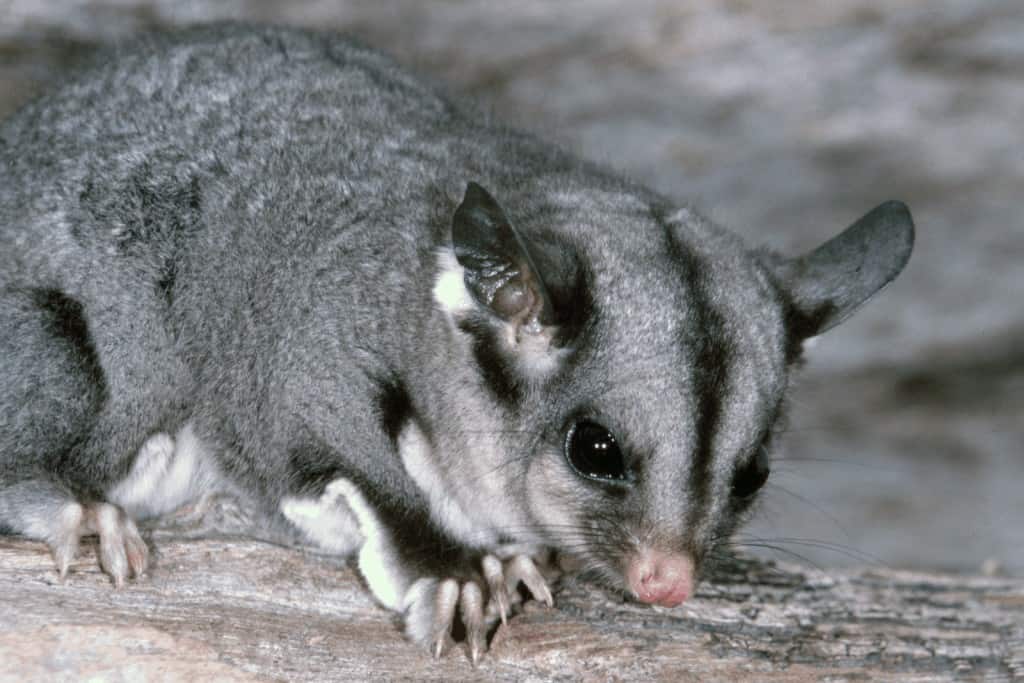
Now let’s see why your sugar bears might be depressed.
1. The Loss of A Companion
Single gliders don’t fare well. Regardless of how much human love and affection you show them, it doesn’t match the companionship they get from another sugar glider.
Once their companion dies due to sickness, or you separate them for any other reason, the sugar glider will feel lonely and depressed.
Running in circles, backflips, and barking are some of the abnormal behaviors lonely sugar gliders may exhibit.
How to Bond with Sugar Glider That Just Lost its Cage Mate?
Sugar gliders are incredibly social creatures, so it’s only natural that you may be worried about your remaining pet now that their cage mate is gone.
The good news is that it’s quite possible to bond with any glider you’re caring for, and we can help you do it!
Here are some easy steps that will help you make this transition easier on both you and your pets.
- Give your sugar glider something new to explore, like a hollow log or hanging branch
- Spend time playing with them every day, but don’t overdo it – these creatures need their rest too!
- Make sure there’s plenty of food available for when they get hungry and want some snacks!
- Take them out of their cage every once in a while. This can be good bonding time as well as fun for both parties involved (but make sure not to leave any open doors or windows open).
- Keep an eye out for signs of discomfort such as hissing noises coming from inside the cage or lethargy after playing together outside of its home environment.
- Consider getting another sugar glider so that he has a companion.
2. Boredom and Lack of Social Interaction
If you raise a single sugar glider, they’ll get bored quickly since they don’t have anyone to play with.
Boredom also occurs if you neglect them for a long time, especially if you’ve already made them used to a certain petting and playtime schedule.
These pets will often bark to try and get your attention.
3. Lack of Exercise
Sugar gliders are high-energy animals, so they need regular exercise to maintain good mental and physical health.
Check out this video!
4. Noisy Environment
According to the Merck Veterinary Manual, sugar gliders are very sensitive to sound. So, if the loud music from your neighbor is sometimes a nuisance to you, think of how music from your house may affect them. [1]
And not just music, noise from urban or industrial centers, when you have people over, are reasons why your sugar gliders may be stressed.
5. Perceived Predators
There are many reasons why a sugar glider may perceive a threat. F
or instance, if you live in a multi-pet household, your sugar glider may be afraid of the cats, dogs, or any other pets you have in your home.
If several people are living in your house, your sugar glider may not have the chance to bond with all of them.
So, she will still be scared of anyone who tries to approach her. Your sugar gliders may also be afraid of their companions.
While you can pair any gender of sugar gliders, not all of them are compatible – forcing them to live together when they don’t want to is a cause of stress.
6. Small Cages
If your sugar glider cage is too small, or if it contains too many items leaving little space for your gliders, they’ll feel stressed out and insecure.
Also, if the cage is not well-maintained (food leftovers, poop, and other debris are left lying around and causing foul odors), your pet will not act normal.
Think about it, would you be happy living in your own waste? If you think this is the cause of your pet’s depression, check out our guide on sugar glider cage cleaning.
7. Poor Room Conditions
Sugar gliders may seem stressed and uncomfortable if the room is too hot or too cold.
Also, smoking around them, burning stinky candles, and so on affects the overall well-being of your pet.
8. Poor Diet
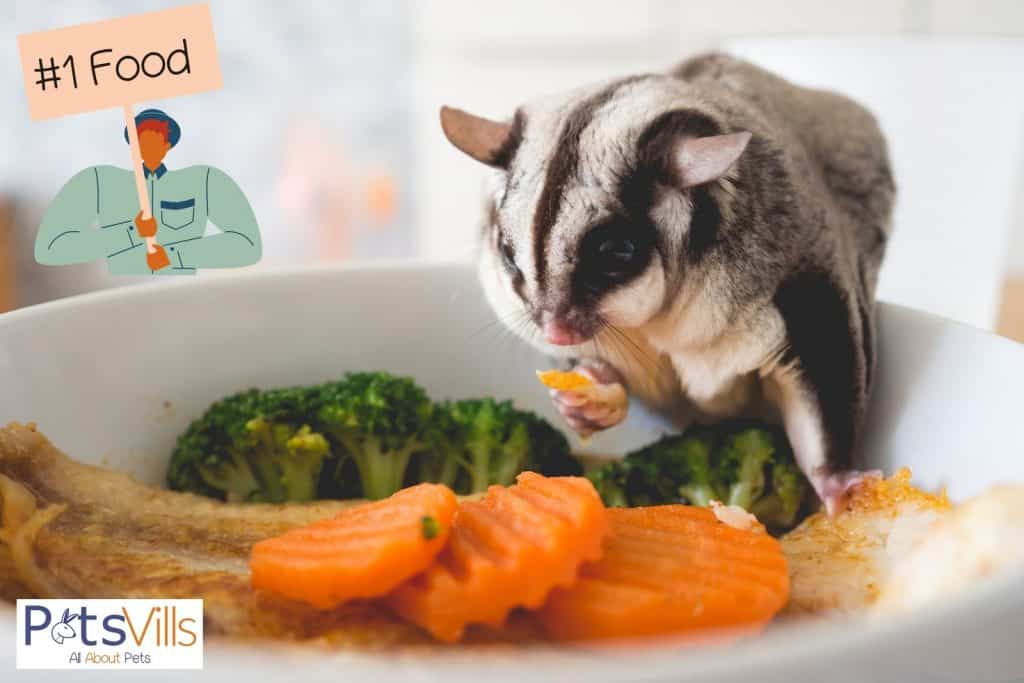
Poor diet is known to cause bad odors in sugar gliders.
Since it also deprives your sugar glider of the necessary nutrients, your sugar gliders will look tired, and lethargic, and they’ll not be motivated to eat. Starvation will eventually lead to death.
9. Illness or Injury
If your sugar glider was running around and injured themselves, they may be stressed when they can’t ease the pain.
Self-mutilation also leads to injuries that, if not treated early, could develop a bacterial infection.
They could also be suffering from pouch disorders due to overgrooming, diarrhea, urinary tract infections, dental disorders, and many other health issues.
If you were injured or sick, you wouldn’t be happy, right?
ALSO READ: Why Is My Sugar Glider Shaking
10. Sexual Frustration
Raising sugar gliders in captivity can be quite tricky. Some aspects, such as breeding, have to change since most people don’t want to breed the sugar gliders.
As a result, unneutered males may experience sexual frustration since they can’t mate as freely as they would in the wild.
How To Keep A Sugar Glider From Depression
The best way to prevent your sugar glider from self-mutilation, refusing to eat, or overgrooming is to deal with what may be causing the stress. Below are some practical ideas.
Take Your Pet To The Vet
You’ll realize that most of the signs of stress are related to some diseases.
So, the first thing you need to do is visit a qualified exotic animal veterinary for diagnosis and treatment.
As a matter of fact, taking your pet at least once a year, even when they’re not showing any signs, helps keep your pet healthy.
Get Your Sugar Glider A Cage Mate
One sugar glider owner compared owning a single sugar glider to being the only human on another planet, and you’ve been taken care of by “aliens.”
Regardless of how much these “aliens” will love you, nothing beats having another human around to keep you company.
Now enough with the aliens. Getting your pet a companion goes a long way in improving their overall physical and mental health.
Once you get a second sugar glider, follow the proper steps of introduction. These include bringing them to a neutral space, making them know each other’s scent, and finally allowing them to make contact.
Make Sure Your Pet Has Enough Room
The ideal cage size for one or two sugar gliders is 24*24*36 inches (LWH). The larger, the better.
Since they love to climb, make sure the cage is tall enough. Place toys, pouches, and any other items that can help enrich your pet in the cage and make sure it’s not crowded.
Check out this video for more ideas:
Spend More Time With Your Pet
As I mentioned earlier, sugar gliders need human affection as they need companionship from another glider.
So, make sure you spend time daily to bond with them, tame them, and even teach them a few tricks. Since they’re nocturnal, the best time to bond with them is at night.
It would be best if you set aside a separate room for playing with them, and where you’ll place all the necessary items.
Once your pet gets to this room, they know it’s time to spend time with their owners.
Make sure the room is safe, and it doesn’t have large spaces where the sugar glider could escape.
Here is a great step-by-step bonding video that will help:
Make Their Room Favorable
I mentioned that temperature fluctuations and poor air quality are some causes of stress.
To prevent this, you can use a thermostat to maintain the ideal temperature and an air purifier to get rid of air contaminants.
If you or a member of your family smokes, they should do it far away from the sugar glider’s room.
Maintain Proper Hygiene
It would help if you cleaned the cage, sugar glider bonding pouches, food bowls, trays, and toys regularly.
You should remove leftover food daily and replace it with fresh food and fresh water.
Dish soap and warm water are good enough to wash the cheap sugar glider cage, so avoid bleach or other cleaning chemicals.
Proper Diet
Replicating what wild gliders eat for pet gliders is often a challenge, and there are several diets advertised online.
The best thing is to consult a qualified vet before trying any diet. But it should basically include pellets, insects, water, vegetables, and fruits as treats.
The Northern Carolina State University also suggests some diets that you can try out, including the Leadbeater’s Mixture. [2]
Sugar Glider Depression (FAQs)
Can sugar gliders die of depression?
Sugar gliders can die of depression. Death can be caused by starvation, self-mutilation, or hurting themselves as they backflip, which all result from sugar glider depression.
How do I tell if my sugar glider is depressed?
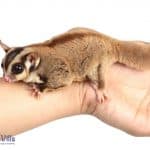
A lack of appetite, self-mutilation, running in circles, weird sleeping patterns, barking unc0ontrollably, lethargy, and overgrooming are some of the signs of sugar glider depression.
What can cause a sugar glider to die?
Toxins in tap water, dehydration due to lack of water or due to diarrhea, aflatoxins in food, are and pasteurellosis are some of the causes of death in sugar gliders.
Why do sugar gliders self-mutilate?
Sugar glider self-mutilation is caused by stress. Some of the causes of stress include small cages, boredom, perceived threats, poor diet, sexual frustration, and noisy environments.
Final Words
And there’s everything you need to know about sugar glider depression.
The next time you observe abnormal behavior with sugar gliders, it’s either depression or illness. Either way, start with taking your glider to the Vet for diagnosis.
Once you’re certain it’s just stress, adjust your home to make it favorable for them.
This includes getting them a cage mate, spending more time with them, feeding them the right foods, making sure they exercise, cleaning their cages and all their items, and maintaining the ideal temperature in the room.
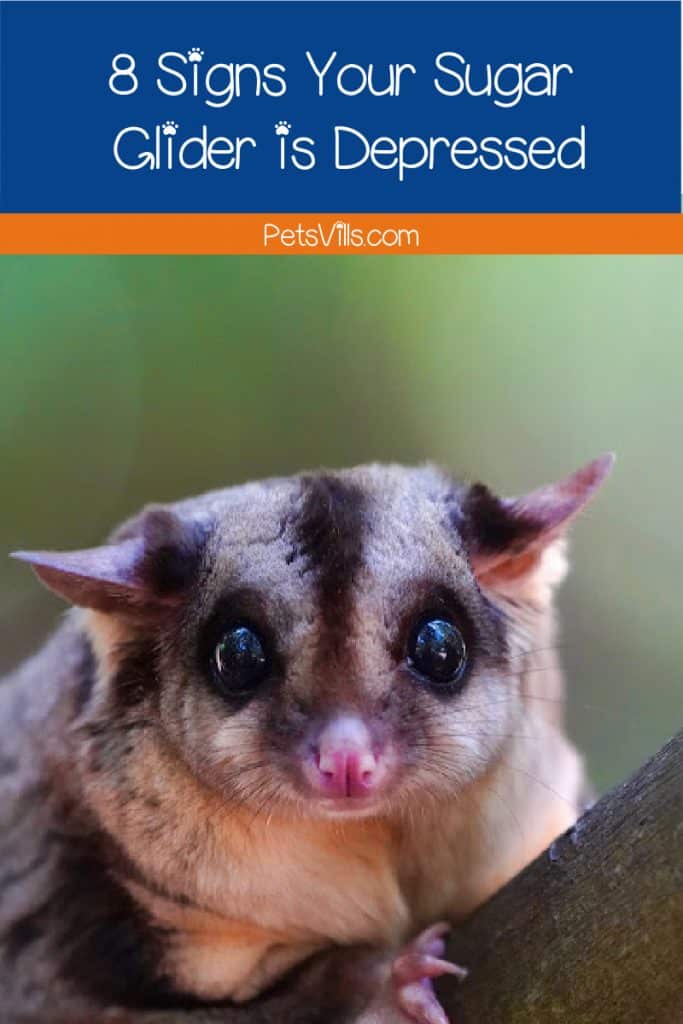
Have you ever dealt with sugar glider depression? Share your experiences below.
Resources
- 1. Sugar Gliders – Exotic and Laboratory Animals [Internet]. Merck Veterinary Manual. Available from: https://www.merckvetmanual.com/exotic-and-laboratory-animals/sugar-gliders/sugar-gliders
- 2. Caring for Your Pet Sugar Glider [Internet]. Available from: https://cvm.ncsu.edu/documents/caring-for-your-sugar-glider/#:~:text=Wild%20sugar%20gliders%20are%20omnivorous
Barry Stingmore is a British content writer living in Fuerteventura, Spain. An animal lover at heart, he shares his home with a dog and four rescue cats and has a passion for writing about animals big and small.
Barry loves finding answers to your animal-related questions, the more research involved the better! You can rely on him to find the facts.
Find him on FACEBOOK, TWITTER AND Linkedin
Read his latest ARTICLES.
Find more about him HERE.

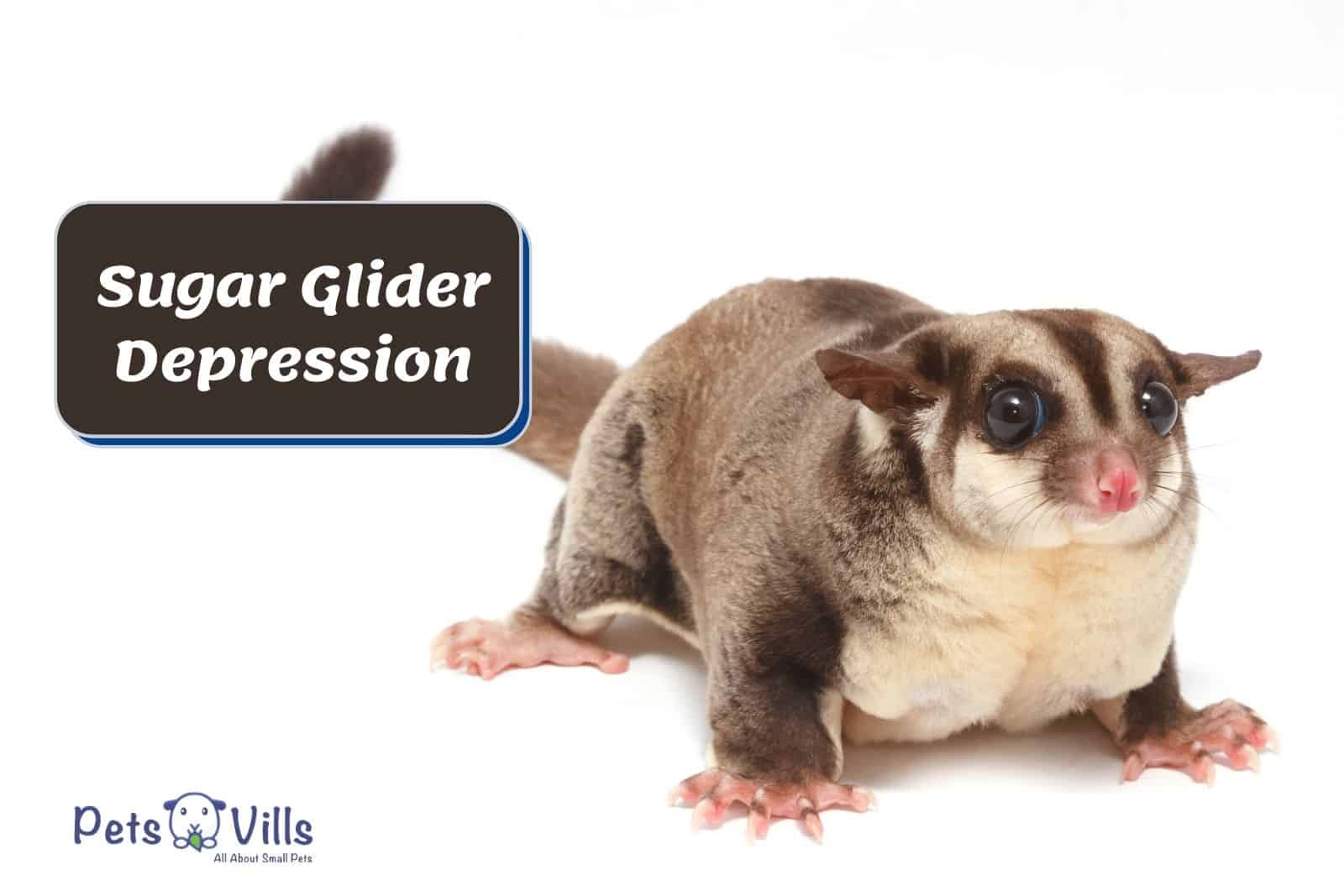


![Cute Sugar Glider Drinking From The Bottle [Must-Watch Video]](https://petsvills.com/wp-content/uploads/2022/09/Cute-Sugar-Glider-Drinking-From-The-Bottle-Must-Watch-Video-211x150.jpg)
